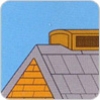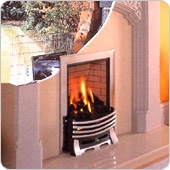Before you buy a gas or solid fuel fire, it’s very important to find out what kind of flue your home has.
A flue is basically a circular or rectangular pipe from which ‘flue’ (or waste) gases can pass out of into the external atmosphere. Different fires are compatible with different flues, with the depth of your flue determining which fire will best fit your home.
The best clue to knowing what type of flue you have is by simply looking at your roof and seeing what kind of outlet it has. Most of our gas fires are class 1, class 2 and precast suitable, however in the case of our wall mounted fires the requirements vary. Always make sure to check the product specifications before making a purchase.
Whilst the below guide is intended to help determine your flue type, we should stress for safety reasons that it is always best to ask a qualified professional for a final decision.
Traditional Chimney
Compatible with all electric, gas and solid fuel fires
Probably the simplest to identify, and very common in older houses which used to have a solid fuel fire. A chimney usually features a traditional chimney stack with either a pot or gas terminal, and simply relies upon the natural circulation of air through your room and up your chimney to expel waste gases. Another feature of this flue type is that there will often be an alcove on either side of your fire.
With a minimal internal diameter of 7 inches, a chimney is compatible with all types of fires, including class 1 and 2 gas fires and solid fuel.

Prefabricated Flues
Compatible with class 1 and 2 gas fires (depending on size)
Ever seen one of these gas terminals on top of a house? This is usually a sign the home has a pre-fabricated flue system. These are made up of metal interlocking flue pipes that connect to a flue box, which in turn connects to the gas terminal. Unlike a chimney which will often create an alcove on either side of your fire, prefabricated flues are usually built into a flat wall.
The compatibility of this flue type depends upon its size. If your prefabricated flue has a minimum diameter of 7 inches, then it should be compatible with both class 1 and class 2 gas fires. If however the diameter is less than this, then it can only be used with class 1 products.

Precast Flue
Compatible with class 2 gas fires
Often a feature in new houses, precast flues are made up of rectangular hollow concrete or clay blocks that travel vertically up through the cavity wall of your property, eventually ending up as a small ridge vent on your roof. Similar to prefabricated flues, precast flues are usually built into a flat wall.
Pre-cast flues are much shallower than prefabricated flues and chimneys, meaning they are only compatible with class 2 gas fires.

Power Flue
Some houses do not have a traditional flue, making a power flue a very attractive option. A power flue basically uses an electronically powered fan to expel the gases the fire produces. The fan is usually semi mounted or surface mounted onto the outside wall, either directly behind or to the side of the gas fireplace. Because of the electric fan, some noise is to be expected.

Balanced Flue
Another option for a house without a traditional flue system, a balanced flue features a gas fire fronted with glass, effectively sealing off the gas from the room. Two horizontal pipes run behind the wall, the inner pipe supplying clean air for combustion, and the outer pipe carrying away the waste gases to outside the house.

Flueless
Some gas fires are able to operate without any flue at all, with the combustion gases produced being converted to harmless carbon dioxide and water vapour via a catalytic convertor. This result is a 100% efficient fire with a low running cost, although you should be aware the appliance requires additional ventilation of least at least 100cm 2. Also note that the room it is installed in must also contain a window that can be opened.








